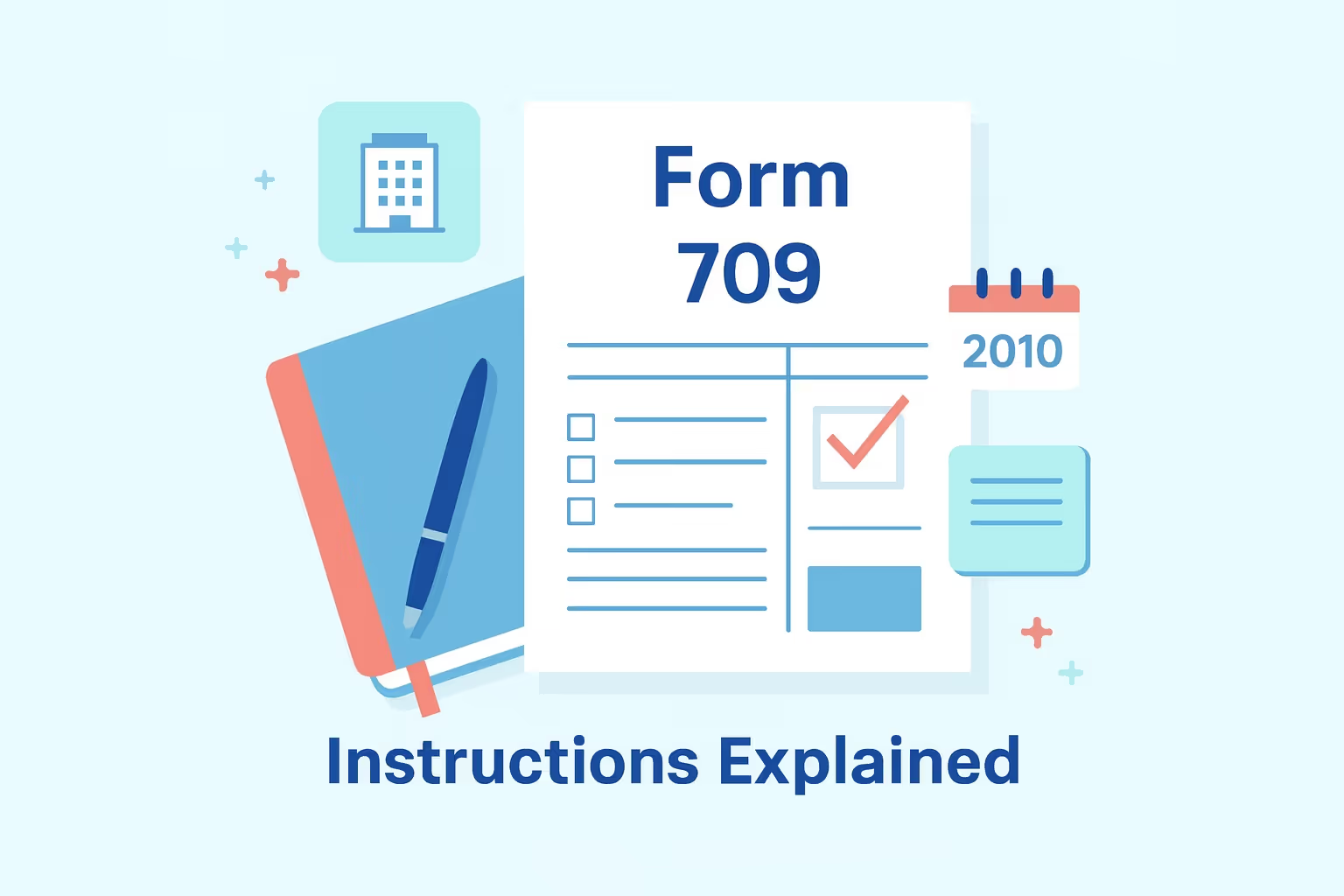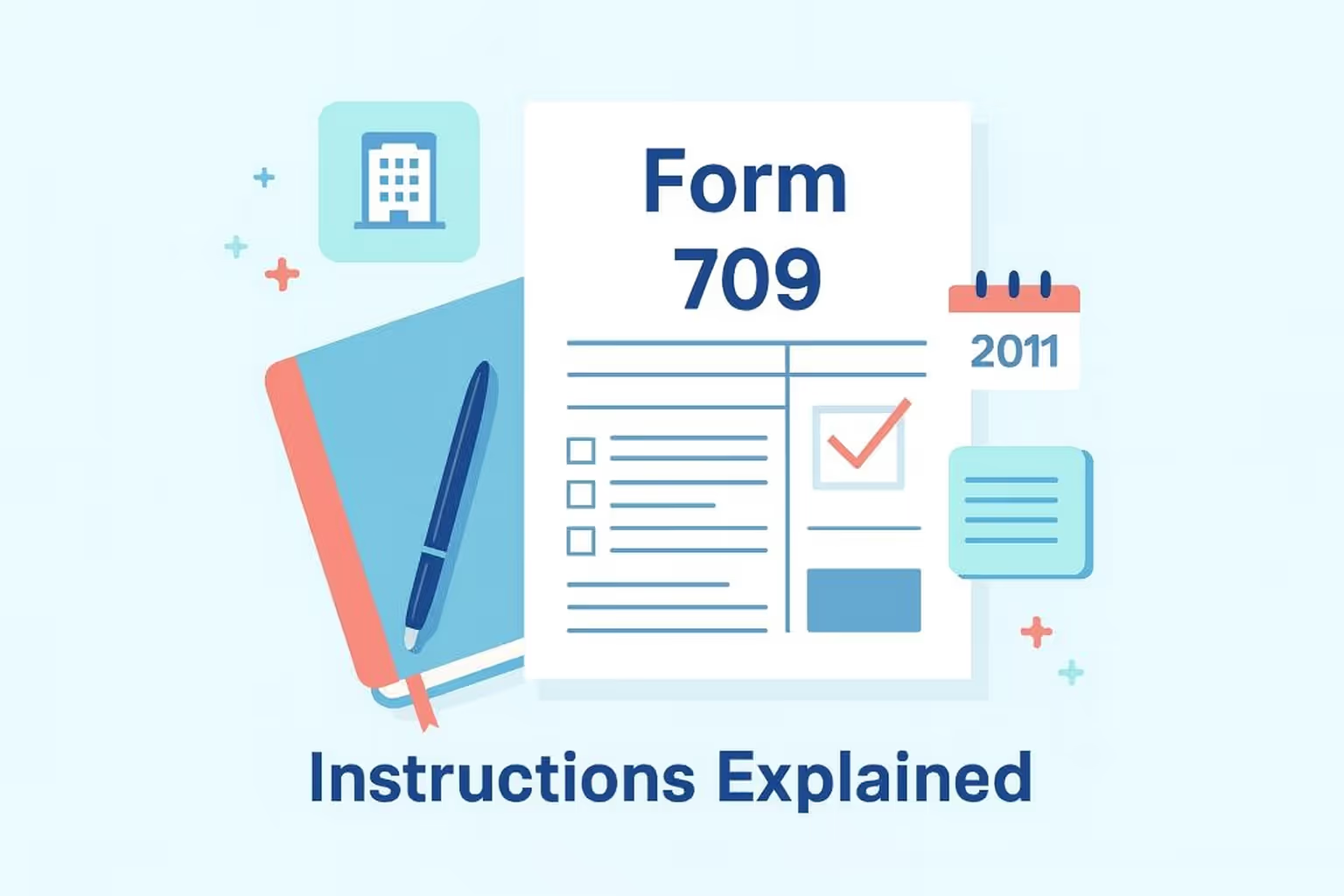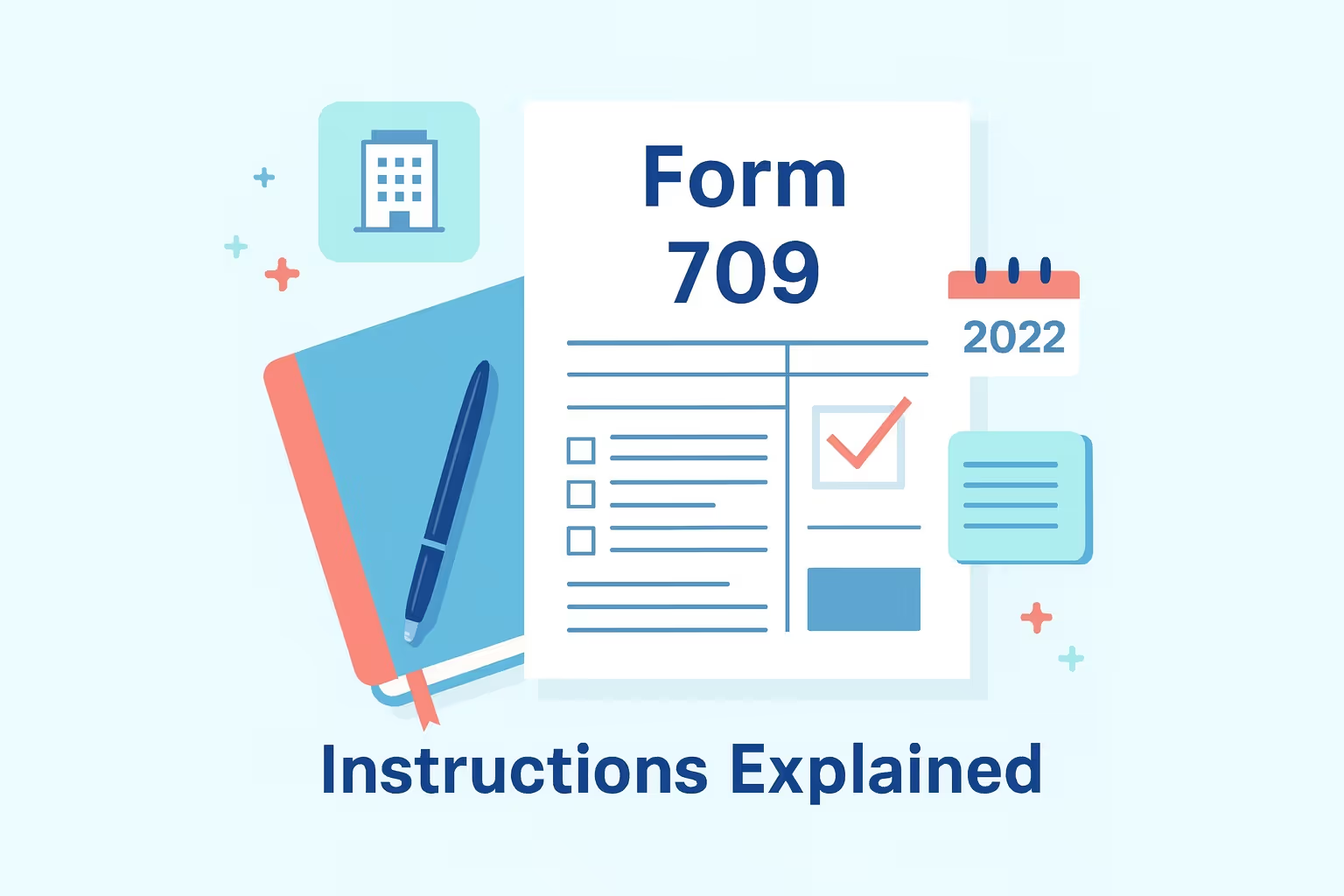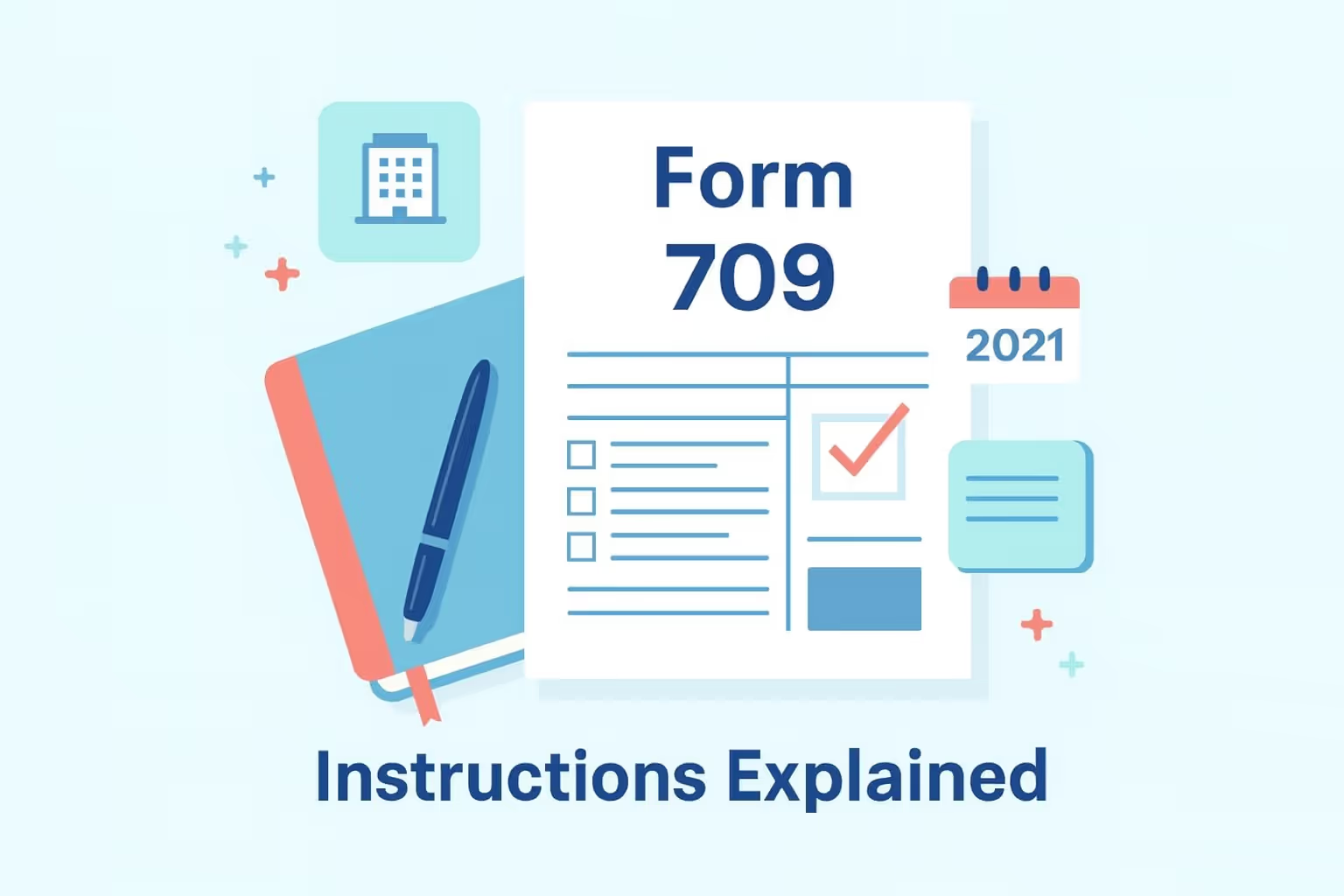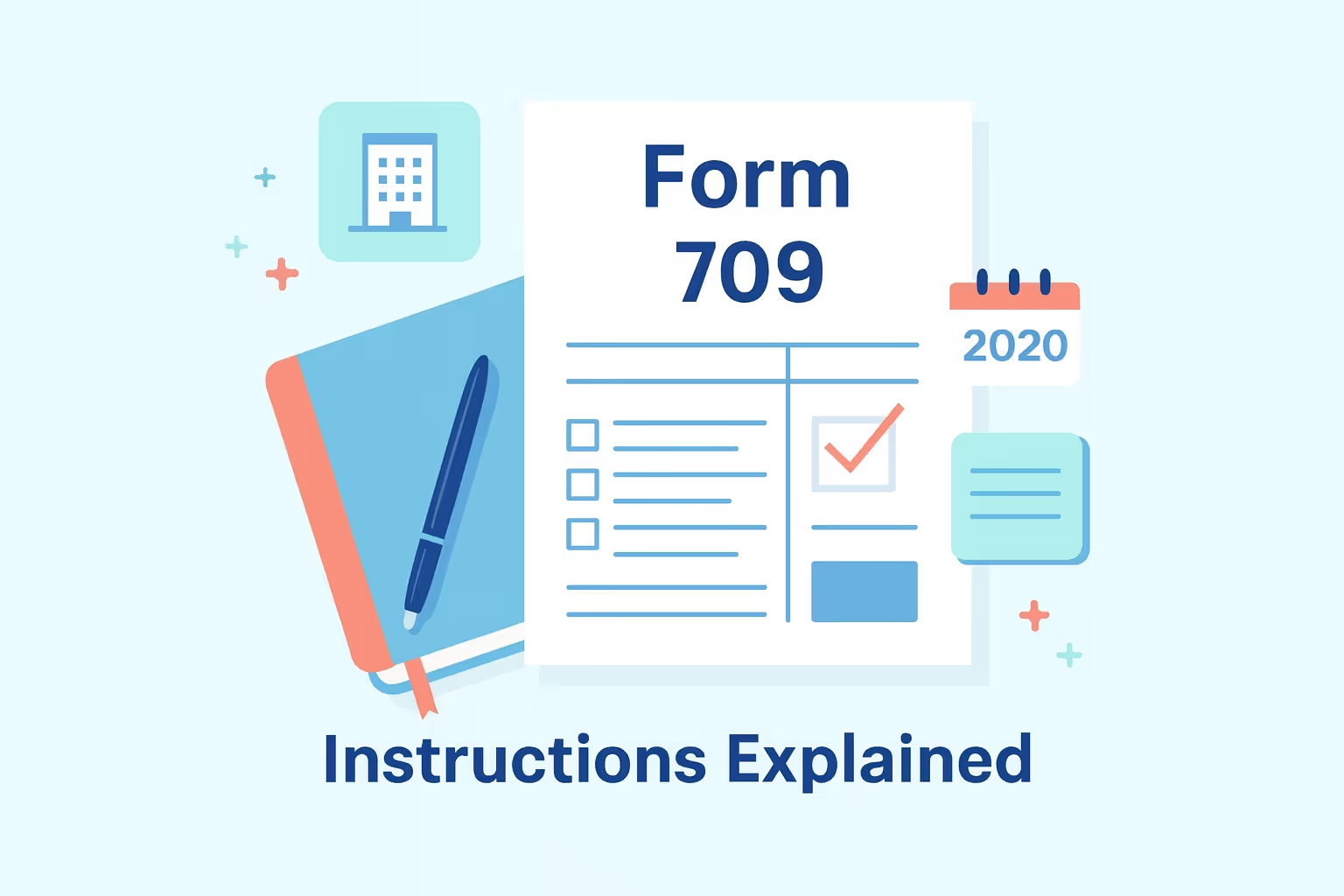How do you file IRS Form 709 for the 2013 Gift Tax Return?

IRS Form 709 is the United States Gift and Generation-Skipping Transfer Tax Return used by individuals to report gifts that may be subject to federal gift tax. For the 2013 tax year, this form was essential because of updated exclusion limits and changes in how gift and estate taxes were applied. Many taxpayers may not realize that giving gifts beyond certain thresholds creates a filing requirement, even when no tax is ultimately owed. Filing ensures the Internal Revenue Service can track lifetime exemption usage and determine whether any gift tax liability exists.
In 2013, the annual gift tax exclusion increased to $14,000 per recipient, while excluding gifts to a non-citizen spouse rose to $143,000. In addition, the lifetime gift and estate tax exemption was adjusted to $5.25 million, with the top federal gift tax rate moving to 40 percent. These adjustments made proper reporting especially critical for individuals making larger gifts or planning their estates. Understanding the difference between present and future interest gifts was also essential, as only certain gifts qualified for the annual exclusion amount.
This guide provides step-by-step instructions for completing Form 709 for the 2013 tax year, including filing requirements, deadlines, payment options, and common mistakes to avoid. Written with a focus on clarity, it is designed for individuals filing a federal gift tax return for the first time and those seeking a refresher on the topic. Readers will gain practical insight into how the rules applied in 2013, ensuring compliance while keeping accurate records for both gift and estate tax purposes.
What Is IRS Form 709?
IRS Form 709, United States Gift and Generation-Skipping Transfer Tax Return, is a federal gift tax return that individuals use to report certain transfers of money or property. It applies when gifts exceed the annual gift tax exclusion amount or when transfers involve generation-skipping transfers. The form is not related to federal income tax but instead tracks gifts for gift and estate tax purposes.
Situations Requiring Form 709
An individual must file Form 709 if any of the following situations apply:
- The person gave gifts in 2013 that exceeded the annual exclusion amount of $14,000 to any one recipient.
- The person made any gift of a future interest, regardless of its value, because future interests do not qualify for the annual exclusion.
- The individual elected to split gifts with a spouse, which requires each spouse to file a separate return even if only one made the gift.
- The person gave gifts to a non-citizen spouse exceeding $143,000, which was the exclusion limit for that year.
- The individual transferred property interests that require reporting for generation-skipping transfer tax purposes.
Who Does Not Need to File
Some individuals do not need to file Form 709 if:
- All gifts made during the year were under the annual exclusion amount for each recipient.
- All gifts were present interests that qualify for the exclusion.
- No election for gift splitting with a spouse was made.
- All gifts to a spouse are qualified for the unlimited marital deduction.
Form 709 is used for gift tax purposes even when no gift tax liability results from filing. It ensures the Internal Revenue Service can track lifetime exemption usage and confirm whether additional estate and gift tax reporting is required later. By filing accurately, individuals protect themselves from future challenges and maintain proper records for estate tax planning.
Key Changes for the 2013 Tax Year
Several vital updates affected the filing of Form 709 in 2013. These changes impacted both the annual exclusion amounts and the overall structure of gift and estate taxes. Understanding these adjustments is essential for anyone preparing a federal gift tax return for that year.
Updated Exclusion and Exemption Amounts
- The annual gift tax exclusion increased from $13,000 in 2012 to $14,000 in 2013 for each gift recipient.
- The annual exclusion for gifts to a non-citizen spouse increased from $139,000 to $143,000.
- The lifetime gift and estate tax exemption increased to $5.25 million, referred to as the basic exclusion amount.
- The top federal gift tax rate increased from 35% to 40%.
Present vs. Future Interest Gifts
- A present interest means the recipient has immediate use or enjoyment of the gift, which qualifies for the annual exclusion.
- A future interest means the recipient will benefit at a later date, which does not qualify for the exclusion and must be reported accordingly.
The 2013 changes emphasized the importance of accurately identifying the type of gift and applying the corresponding exclusion or exemption. For taxpayers with larger estates, these adjustments also affected long-term estate tax planning strategies.
Step-by-Step Filing Instructions
Completing Form 709 for 2013 requires careful attention to detail. The filing process is structured around specific parts and schedules of the form, and each section must be completed accurately and thoroughly.
Pre-Filing Checklist
- Collect records of all gifts made during 2013, including recipient details and gift values.
- Gather prior year Form 709 returns, if applicable, for continuity.
- Obtain fair market value appraisals for real estate, business interests, or valuable property.
- Confirm whether gift splitting with a spouse will be elected.
Completing Part 1 – General Information
- Provide personal information, including name, address, and Social Security number.
- Indicate filing status, whether an extension was filed, and the number of gift recipients.
- Confirm any election for gift splitting and ensure the donor spouse’s return is signed if required.
Schedule A – Computation of Taxable Gifts
- Part 1 is used for gifts subject only to gift tax, such as those made to children or other non-skip persons.
- Part 2 is used for direct skips, such as gifts to grandchildren, which may be subject to the generation-skipping transfer tax.
- Part 3 is used for indirect skips, such as transfers to trusts that could later benefit skip persons.
- Part 4 reconciles the total taxable gifts after applying exclusions and deductions.
Schedule B – Gifts From Prior Periods
- Report any prior taxable gifts and the unified credit used in those years.
- Provide the IRS office where earlier returns were filed.
Part 2 – Tax Computation
- Enter the total taxable gifts for the year.
- Use the IRS rate table to determine tax liability.
- Apply credits, exemptions, and any unused exclusion for deceased spousal if available.
Following these steps carefully ensures accurate reporting of taxable gifts and reduces the risk of errors that could delay processing or result in penalties.
Filing Deadlines and Extensions
The Internal Revenue Service requires the timely filing of Form 709 to remain compliant. Deadlines for the 2013 gift tax return were linked to the standard tax year schedule.
Filing Deadlines
- The regular due date for the 2013 return was April 15, 2014.
- An extension allowed filing until October 15, 2014, but any tax owed was still due by April 15.
- If the donor died during 2013, the filing deadline matched the due date of the estate tax return or April 15, 2014, whichever came first.
Extension Requests
- Taxpayers could use Form 4868 or Form 2350 to extend the deadline for filing their federal income tax return, which also extended the deadline for filing the gift tax return.
- Alternatively, Form 8892 could be explicitly filed to extend the deadline for Form 709.
- Extensions applied only to filing, not to payment of gift tax liability.
Mailing Addresses for 2013 Filings
- Standard mail returns were sent to Cincinnati, Ohio's Internal Revenue Service Center.
- Private delivery services directed returns to the IRS office in Covington, Kentucky.
Meeting the filing deadline is critical because late submissions can result in penalties and interest on unpaid balances. Taxpayers should plan and use extensions if necessary to ensure that Form 709 is completed accurately and submitted on time.
How to Pay Gift Tax?
When filing Form 709, some individuals may discover they owe federal gift tax. Payment is required when the taxable gift amount exceeds the applicable exclusion amount or when the lifetime exemption has been exhausted.
When is payment required?
- A balance due appears when total taxable gifts for the year exceed available credits.
- A payment is also necessary if the cumulative value of lifetime gifts surpasses the basic exclusion amount.
- Payment is required even when filing on time if no credit remains to offset the liability.
Payment Methods
- A check or money order payable to the United States Treasury may be attached to the return. The taxpayer’s Social Security number and “Form 709” should be written on the payment.
- Electronic payments can be made through the Electronic Federal Tax Payment System (EFTPS).
- Payments may also be submitted by phone using the IRS automated system or through online banking at participating institutions.
Installment Agreements
- If full payment cannot be made, filing the return on time is still required.
- Taxpayers may request an installment agreement from the Internal Revenue Service.
- Interest and penalties accrue on unpaid balances until the liability is satisfied.
Paying the correct amount of tax when due prevents additional costs and ensures compliance. Using approved payment methods also helps avoid delays or misapplied payments.
Required Schedules and Attachments
Form 709 requires supporting schedules and documents to verify the accuracy of the return. These attachments detail the types of gifts made, the fair market value assigned, and any exemptions claimed.
Schedule A – Computation of Taxable Gifts
- Part 1 lists gifts subject only to gift tax, such as transfers to children or friends.
- Part 2 lists direct skips, subject to both gift and generation-skipping transfer tax.
- Part 3 lists indirect skips, such as transfers to trusts that may later benefit skip persons.
- Part 4 reconciles taxable gifts after applying annual exclusions and deductions.
Schedule B – Gifts From Prior Periods
- Schedule B provides details of gifts that were reported on earlier gift tax returns.
- It lists all taxable gifts made in prior years.
- It shows the unified credit that was used in those years.
Schedule C – Deceased Spousal Unused Exclusion
- Schedule C allows using the deceased spouse’s unused exclusion when portability has been elected.
- It requires information from the deceased spouse’s estate tax return.
Schedule D – Generation-Skipping Transfer Tax
- Schedule D reports transfers that are subject to the generation-skipping transfer tax.
- It provides reconciliation of the lifetime GST exemption available to the filer.
Required Attachments
- Appraisals for real estate, business interests, or unique assets.
- Trust documents, including identification of beneficiaries.
- Explanations for valuation discounts or elections claimed.
Attaching complete schedules and documents helps establish adequate disclosure and protects against future IRS challenges.
Common Mistakes to Avoid
Errors on Form 709 can result in processing delays, penalties, or future disputes with the IRS. Many of these mistakes are common among first-time filers.
Filing Requirement Errors
- Some taxpayers fail to file when making gifts of future interests, which must always be reported.
- Others misapply the exclusion for gifts to non-citizen spouses, which was $143,000 in 2013 and not the standard $14,000.
- Couples sometimes attempt to file a joint gift tax return, which is not permitted. When electing to split gifts, each spouse must file individually.
Valuation Errors
- Failure to use the fair market value at the time of the gift results in inaccurate reporting.
- Omission of qualified appraisals for real estate or business interests can result in IRS challenges.
- Discount calculations for lack of marketability or minority interests must be well-documented.
Schedule and Calculation Errors
- Taxpayers sometimes place gifts in the incorrect section of Schedule A, resulting in inaccurate reporting.
- Some filers leave out required recipient information or record the wrong dates for gifts.
- Errors occur when the annual exclusion is incorrectly calculated or not appropriately applied.
- Mistakes are often made when reconciling prior year gifts on Schedule B, resulting in inaccurate totals.
Avoiding these mistakes requires careful attention to instructions and accurate recordkeeping. Reviewing the return before filing reduces the likelihood of errors and ensures compliance with the Internal Revenue Code.
First-Time Filer Tips
Filing an individual gift tax return for the first time can feel overwhelming. Understanding the basic rules and preparing properly can make the process easier and help avoid unnecessary complications.
Key Differences to Understand
- Gift tax is separate from federal income tax. The donor, not the recipient, is responsible for reporting and paying any applicable federal gift tax.
- The annual exclusion allows tax-free gifts up to a specific limit per recipient each year. In 2013, the annual exclusion amount was $14,000.
- The lifetime exemption, also known as the basic exclusion amount, protects larger gifts from immediate tax but reduces the estate tax exemption available at the time of death.
Recordkeeping Best Practices
- Keep copies of all Form 709 filings to track lifetime gift and estate tax planning.
- Retain property valuations and appraisals to demonstrate fair market value at the time of the gift.
- Store documentation for gifts made to trusts, qualified tuition programs, or medical expenses.
When to Seek Professional Assistance?
- Consulting a tax professional is recommended when gifts involve business interests, real estate, charitable transfers, or complex trust structures.
- A professional can also help when using the deceased spousal unused exclusion, making elections for qualified terminable interest property, or reporting inter vivos direct skips.
- Guidance is especially valuable for individuals coordinating estate and gift tax planning strategies to maximize both the marital deduction and applicable exclusions.
First-time filers benefit from understanding that Form 709 is not simply a formality. Accurate preparation helps manage long-term financial planning, ensures compliance with the Internal Revenue Service, and protects against future issues involving estate and gift tax obligations.
Frequently Asked Questions
What are the Form 709 2013 instructions?
The Form 709 2013 instructions guide the completion of the federal gift tax return, used to report gifts made during that tax year. The Internal Revenue Service explains how to calculate the value of each taxable gift, apply the annual gift tax exclusion, and determine whether any gift tax liability results. These instructions also clarify the connection between gift and estate taxes and explain recordkeeping requirements for future estate tax purposes.
When does the gift tax apply?
The gift tax applies when gifts made to any individual exceed the annual exclusion amount, which was $14,000 in 2013. A taxable gift can include cash, property interest, or even certain gifts such as transfers to trusts. While many transfers qualify as tax-free gifts under exemptions, the Internal Revenue Code requires individuals to file gift tax returns when limits are exceeded, even if no immediate tax liability is due.
How does the annual gift tax exclusion work?
The annual gift tax exclusion allows taxpayers to give up to a specific limit per gift recipient each year without owing federal gift tax. In 2013, the annual exclusion amount was $14,000. Gifts within this exclusion are considered tax-free for gift tax purposes. Any gifts made beyond this exclusion will count toward the lifetime exemption and may result in future estate tax consequences if not correctly reported.
Can married couples file a joint gift tax return?
Married couples cannot file a joint gift tax return. Instead, each spouse must file an individual gift tax return if gifts exceed the annual exclusion or if they elect to use gift splitting. When a spouse elects gift splitting, both returns must reflect the election. This process allows gifts to be treated as though made half by each spouse, maximizing the use of exclusions and protecting future estate tax exemption amounts.
What is the lifetime exemption for estate and gift tax purposes?
The lifetime exemption, also known as the basic exclusion amount, represents the total value of gifts and transfers that can be made without incurring federal gift tax or reducing the estate tax exemption at death. For 2013, the applicable exclusion amount was $5.25 million. The Internal Revenue Service tracks all lifetime gifts through Form 709, and using this exemption reduces the amount available for the taxable estate later.
How should gifts of property be valued for a federal gift tax return?
For federal gift tax return purposes, all gifts must be reported at fair market value as of the date they were made. This requirement applies to real estate, business interests, and other property interests. Taxpayers often obtain professional appraisals to establish accurate values. Proper valuation ensures compliance with the Internal Revenue Code and prevents disputes with the Internal Revenue Service about the actual value of taxable gifts or deductible gifts.
When should a tax professional be consulted about Form 709?
A tax professional should be consulted when gifts involve trusts, qualified tuition programs, medical exclusions, charitable gifts, or complex family transactions. Professional advice is essential when using the deceased spouse’s unused exclusion, applying the marital deduction, or electing qualified terminable interest property treatment. Working with an advisor ensures compliance with the Internal Revenue Service rules, accurate reporting of taxable gifts, and effective planning for both gift and estate taxes.



























